|
|
The aim of this page is to give a general
idea of the social activities which are foreseen for the
conference.
In particular, a visit of the famous Royal Abbey of
Fontevraud, which is presented briefly below, is planned. A
visit of some prestigious wines cellars such as Ackerman or
Bouvet-Ladubay, and wine tastings are also programmed.
The diner will take place in the refectory of the
Royal Abbey of Fontevraud.
The Royal Abbey of Fontevraud - 900 years of
history
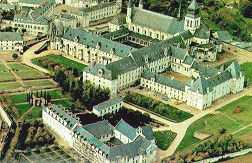
|
Founded in 1101 by Robert d'Arbrissel
and ruled over for centuries by the most powerful of
abbesses, the Abbey of Fontevraud was, before the
Revolution, the richest and most important monastery
in France.
The Abbey is composed of several
buildings and spreads over almost 15
hectares. Each building was dedicated to a specific monastic
category. Some of these buildings were destroyed during the French Revolution but must of them are still intact.
|
The Abbey church
The Abbey church was built in the XIIth
century. Its dimensions (85m on 16m and the transept
makes 38m length) are the testimony of the importance
of the monastery. The Chorus surrounded by a
ambulatory and the transept were
built first, the nave was carried out then.
The Cloister of the Great
Minister
Like all cloisters, its purpose was
to provide a convenient and protected structure to
communicate between the different components of the
abbey. Thus all conventional life was concentrated
around this square.
The location of the various living
accommodations of Fontevraud followed the Benedictine
plan: to the north, the church; to the east, the
sacristy, the chapter house, the community hall; to
the south, the refectory; to the west, the
outbuildings.
|
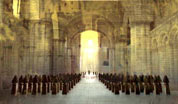
|

|

|
Kitchens and the Refectory
The Abbey has original kitchens
arranged as an octogone with many chimneys. These kitchens were restored at the
beginning of the XXth century. Related to these
kitchens, the Abbey has a large Refectory where the ICEIS 2003 Conference dinner will take place.
|
The refectory is a vast room, which
welcomed the great number of religious who were present
at the Abbey in the Middle Ages. It was built over Romanesque
foundations by Renée
de Bourbon in the early 16th century. Although Gothic in style,
the refectory's vaults form an almost perfect
semi-circular arch. Corbels and keystones are of
remarkable quality.
|
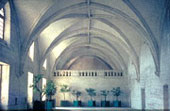
|
For more information, please consult the site
www.abbaye-fontevraud.com.
Ackerman Laurance
The Maison Ackerman Laurance, the
Oldest House of Wine in Saumur was created in 1811 by
Jean Ackerman, the very first sparkling wine
maker. Jean Ackerman gave his name to the main street
of Saint-Hilaire-Saint-Florent.
Since 1956, the Maison Ackerman
Laurance has been part of the Rémy Pannier Ackerman
Laurance Group. This group, leader in the Loire's wine
market, employs 210 people. Moreover, it has a
turnover of 53 Million euros with more than 56% in
exports and produces each year 30 million bottles of
which 12 million are sparkling wines.
In 1811 these cellars were not the
same as today. At the time Jean Ackerman discovered
tufa quarries put to other purposes from which no
limestone blocks had been extracted for several
years.
|

|
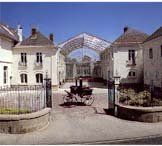
|
Bouvet-Ladubay
Founded by the visionary Etienne
Bouvet in 1851, Bouvet-Ladubay is one of the most
respected wine-producing firms of the Loire
Valley. The house's reputation has been founded not
only on the superb quality of its wines, but also on a
spirit of innovation and the art of living which has
marked its activities from the outset. Its affiliation
as a subsidiary of Champagne Taittinger since 1974 has
heightened its image and lent the firm greater
long-term access to the finest vineyards of the Loire
Valley.
Patrice Monmousseau, President
Directeur General since 1971, is the creative force
behind Bouvet-Ladubay Art Concept, a center for
contemporary art in which the art of wine, the art of
living and the contemporary plastic and performing
arts are united. Its goal is to present new
perspectives in thought, research and expression from
a diversity of creative disciplines. Its epicenter is
a gallery of nine exhibition halls each of which is
given for a period to a living, accomplished artist
who installs his own exposition.
|
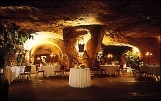
|
Page Updated on
19-10-2006
Copyright © Escola Superior de Tecnologia
de Setúbal, Instituto Politécnico de Setúbal |










